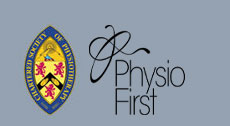|
Medical Conditions Eighty per cent of adults will suffer from back pain at some point in their lives. In many cases, back pain results from poor posture, repetitive strain or occurs suddenly following sports injury or lifting something heavy. Causes of mechanical back pain include inflammation, degeneration or damage to spinal joints, vertebral discs, spinal muscles, ligaments and nerves. “Sciatica” is the term given to irritation or compression of the lumbar nerves and often radiates pain into the back of the leg. In rarer cases, back pain is associated with progressive, degenerative disease processes of the spinal bones and joints. Physiotherapy treatment for back pain, following assessment and diagnosis, may include pain relief, hands-on spinal mobilisation, soft tissue manipulation, acupuncture, traction and exercises to strengthen the muscles which support the spine. If you are prone to episodes of back pain and sciatica, physiotherapy can also provide expert preventative advice. Neck pain can sometimes result from the sudden action of lifting something heavy, repetitive movement, or prolonged poor posture when driving, at work, DIY activity or even from your sleeping position. Often severe pain and stiffness in the joints and muscles of the neck occurs following road traffic accidents. This type of injury is known as “whiplash” and early advice and treatment can help resolve the symptoms quickly. Treatment may vary according to the nature and cause of the neck pain and can include joint mobilisation, electrotherapy, acupuncture and advice regarding exercise and postural re-education to prevent reoccurrence of pain. We can advise on orthopaedic pillows and supports to minimise effects poor sleeping postures upon the neck and spine. The unpredictable changes of direction, movement and speed during sporting activity of all types can result in injury. These may include direct impact to the body, ligament sprain, muscles strains and tears, tendonitis and even broken bones! Physiotherapy may include advice and management of the injury in its acute phase using electrotherapy, heat/cold therapy and appropriate use of tape, braces and supports. We can guide you through graded rehabilitation exercises to help your safe return to sporting activity as soon as possible. Repetitive strain injury (RSI) is the term given to the overuse of muscles, tendons, joints and nerves of the upper limb. It usually occurs as a result of repetitive movement over a prolonged period of time. Commonly related to poor workplace postures or movements, the incidence of RSI has sharply risen due to increased use of keyboard and office work, although musicians, shop staff and factory workers can also be at risk. In addition to preventative advice, including assessment of the workplace or aggravating activity, physiotherapy may involve stretching exercises, postural taping, acupuncture and electrotherapy to restore mobility and normal function of the affected structures. There are many different types of arthritis, the most common being osteoarthritis. It is often given the term “wear and tear”. If you have wear and tear in the neck or back, it is called spondylosis. It occurs when the smooth covering of the joint surfaces wears away causing inflammation, pain, swelling and stiffness. A joint which has wear and tear in it does not necessarily give you pain – it is the strain which you put on the joint which unsettles it. If you keep the joint mobile, and the muscles that support it strong, symptoms can be controlled. Physiotherapy cannot alter the disease process within the joints but plays a vital role in pain management improving strength, mobility, co-ordination and posture. Treatments may include heat and cold therapy, acupuncture and relaxation techniques, tailored exercise programmes and practical advice regarding the pacing of everyday tasks to promote independence. There can be numerous causes for headaches. One of the most common is due to excessive tension in the muscles which move the neck and shoulders causing stiffness in the spinal joints of the neck. Tension in the muscles which move the jaw can also produce headaches especially if you grind your teeth. Physiotherapy can help by identifying and correcting aggravating postures, promoting relaxation and restoring mobility of the joints and soft tissues at fault. Acupuncture can also assist in the treatment of headaches. There are many different reasons for shoulder pain therefore accurate assessment is important to identify the source of the problem. It is necessary to distinguish between pain originating from the neck but referring to the shoulder and a local tendon or soft tissue problem (rotator cuff strain/tear). Pain in the shoulder region is often given the term “frozen shoulder”. A true frozen shoulder is characterised by a progressive tightening of the capsule surrounding the ball and socket of the shoulder joint. Over time this produces a painful limitation of upper limb movement. In some cases, the pain can radiate as far down as the wrist and it can interfere greatly with everyday activity. This type of pain can result from degenerative joint disease eg. Osteoarthritis, or following trauma, injury or a period of immobility. However there is a lot of confusion about the exact diagnosis, how long it lasts and what the best treatments are. A thorough assessment with a physiotherapist will help diagnose the cause of pain and assist in choosing the appropriate plan of treatment to restore movement, function and prevent further injury to the shoulder |
||||
 |
 |
Copyright © Carlisle Physiotherapy & Sports Injury Clinic |
